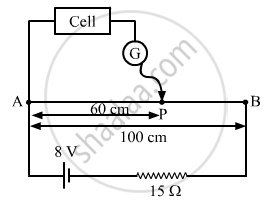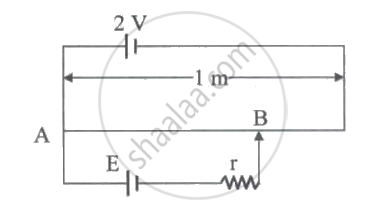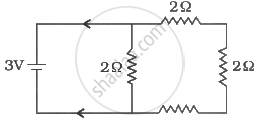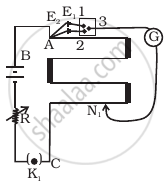Advertisements
Advertisements
Question
A potentiometer wire of length 1 m has a resistance of 5 Ω. It is connected to a 8 V battery in series with a resistance of 15 Ω. Determine the emf of the primary cell which gives a balance point at 60 cm.
Solution

From the figure:
Total resistance of the circuit, R = (RAB + 15) Ω = 20 Ω
Current in the circuit ,
\[i = \frac{V}{R} = \frac{8}{20} A\]
∴ Voltage across AB, VAB = i.RAB = 2 V
The emf of the cell connected as above is given by: \[e = \frac{l}{L} V_0\]
Here:
l = 60 cm (balance point)
AB = L = 1 m = 100 cm (total length of the wire)
\[\therefore e = \frac{60}{100}\left( 2 \right) = 1 . 2 V\]
APPEARS IN
RELATED QUESTIONS
What will be the effect on the position of zero deflection if only the current flowing through the potentiometer wire is decreased?
The instrument which can measure terminal potential difference as well as electromotive force (emf) is ______
Which of the following is true for a potentiometer?
In the given figure, battery E is balanced on 55 cm length of potentiometer wire but when a resistance of 10 `Omega` is connected in parallel with the battery, then it balances on 50 cm length of the potentiometer wire. The internal resistance r of the battery is ____________.

A potentiometer wire of length 100 cm and resistance 3 `Omega` is connected in series with resistance of 8 `Omega` and an accumulator of 4 volt whose internal resistance is 1 `Omega`.
It is observed in a potentiometer experiment that no current passes through the galvanometer when the terminals of the cell are connected across a certain length of the potentiometer wire. On shunting the cell by a 2 Ω resistance, the balancing length is reduced to half. The internal resistance of the cell is ______.
What is the current I in the circuit as show in fig.

In an experiment with a potentiometer, VB = 10V. R is adjusted to be 50Ω (Figure). A student wanting to measure voltage E1 of a battery (approx. 8V) finds no null point possible. He then diminishes R to 10Ω and is able to locate the null point on the last (4th) segment of the potentiometer. Find the resistance of the potentiometer wire and potential drop per unit length across the wire in the second case.

As a cell age, its internal resistance increases. A voltmeter of resistance 270 Ω connected across an old dry cell reads 1.44 V. However, a potentiometer at the balance point gives a voltage measurement of the cell as 1.5 V. Internal resistance of the cell is ______ Ω.
In a potentiometer, a cell is balanced against 110 cm when the circuit is open. A cell is balanced at 100 cm when short-circuited through a resistance of 10 Ω. Find the internal resistance of the cell.
